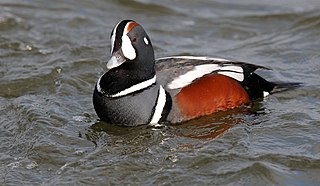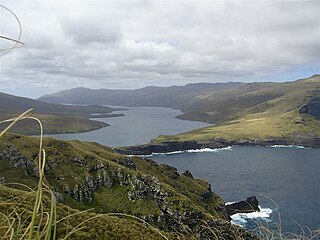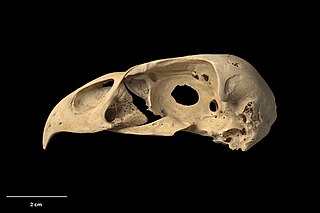
The sea ducks (Mergini) are a tribe of the duck subfamily of birds, the Anatinae. The taxonomy of this group is incomplete. Some authorities separate the group as a subfamily, while others remove some genera. Most species within the group spend their winters near coastal waters. Many species have developed specialized salt glands to allow them to tolerate salt water, but these are poorly developed in juveniles. Some of the species prefer riverine habitats. All but two of the 22 species in this group live in far northern latitudes.

The common merganser or goosander (Eurasian) is a large seaduck of rivers and lakes in forested areas of Europe, Asia, and North America. The common merganser eats mainly fish. It nests in holes in trees.

The red-breasted merganser is a duck species that is native to much of the Northern Hemisphere. The red breast that gives the species its common name is only displayed by males in breeding plumage. Individuals fly rapidly, and feed by diving from the surface to pursue aquatic animals underwater, using serrated bills to capture slippery fish. They migrate each year from breeding sites on lakes and rivers to their mostly coastal wintering areas, making them the only species in the genus Mergus to frequent saltwater. They form flocks outside of breeding season that are usually small but can reach 100 individuals. The worldwide population of this species is stable, though it is threatened in some areas by habitat loss and other factors.

Mergus is the genus of the typical mergansersmur-GAN-sərz, fish-eating ducks in the subfamily Anatinae. The genus name is a Latin word used by Pliny the Elder and other Roman authors to refer to an unspecified waterbird.

The red-billed gull, also known as tarāpunga and once also known as the mackerel gull, is a native of New Zealand, being found throughout the country and on outlying islands including the Chatham Islands and subantarctic islands. It was formerly considered a separate species but is now usually treated as a subspecies of the silver gull.

Auckland Island is the main island of the eponymous uninhabited archipelago in the Pacific Ocean. It is part of the New Zealand subantarctic area. It is inscribed in the UNESCO World Heritage list together with the other New Zealand Subantarctic Islands in the region.

The Brazilian merganser is a South American diving duck in the Mergus genus. It is one of the most threatened waterfowl species in the world, with possibly fewer than 250 birds in the wild and a small number kept in captivity in Brazil. It has a long, sharp-edged beak with a great number of tooth-like edges.

The scaly-sided merganser or Chinese merganser is an endangered typical merganser. It lives in Manchuria and extreme Southeast Siberia, breeding in the north and wintering in the south.

The New Zealand merganser, also known as Auckland merganser or Auckland Islands merganser, was a typical merganser which is now extinct.

The adzebills, genus Aptornis, were two closely related bird species, the North Island adzebill,, and the South Island adzebill,, of the extinct family Aptornithidae. The family was endemic to New Zealand. A tentative fossil species,, is known from the Miocene Saint Bathans fauna.

The North Island takahē is an extinct rail that was found in the North Island of New Zealand.

Eyles's harrier is an extinct bird of prey that was endemic to New Zealand. Its closest relative is the smaller and related swamp harrier, which arrived in New Zealand after its extinction.

The New Zealand quail, or koreke in Māori, is an extinct quail species endemic to New Zealand. The male and female were similar, except the female was lighter. The first scientist to describe it was Sir Joseph Banks when he visited New Zealand on James Cook's first voyage. Terrestrial and temperate, this species inhabited lowland tussock grassland and open fernlands. The first specimen to be obtained by a European was collected in 1827 by Jean René Constant Quoy and Joseph Paul Gaimard on Dumont D'Urville's voyage. It most likely went extinct due to diseases from introduced game birds.

The tomtit is a small passerine bird in the family Petroicidae, the Australasian robins. It is endemic to the islands of New Zealand, ranging across the main islands as well as several of the outlying islands. In Māori, the North Island Tomtit is known as miromiro and the South Island Tomtit is known as ngirungiru. This bird has several other Māori and English names as well. There are several subspecies showing considerable variation in plumage and size. The species is not threatened and has adapted to the changes made to New Zealand's biodiversity.

The Chatham penguin, also known as the Chatham crested penguin, Chatham Islands penguin, or Warham's penguin, is an extinct species of crested penguin previously endemic to the Chatham Islands of New Zealand. It is known only from subfossil bones and probably became extinct within 150–200 years after Polynesians arrived in the Chatham Islands around 1500 CE.

Beeveria is a genus of moss endemic to New Zealand, in the family Daltoniaceae. It is a monotypic genus with characteristics of the type species, including solely the species Beeveria distichophylloides. The name honours the New Zealand bryologist Jessica Eleanor Beever.
Ichneutica seducta is a moth of the family Noctuidae. This species is endemic to New Zealand. It is found only in the Chatham Islands and inhabits native forest. The life history of this species is unknown but the larval host species is likely to be Dracophyllum arboreum. The adults of this species are on the wing from November to January and are attracted to light.
Ichneutica thalassarche is a moth of the family Noctuidae. This species is endemic to New Zealand and is only found in the Chatham Islands. It has been collected at Chatham Island, Pitt Island and Rangatira Island. The life history of this species is unknown as are the host species of its larvae. The adults of this species are large with a pale grey throax and forewing. A diagnostic feature is the pattern on its forewing which is a white subterminal line joined by black "teeth" markings. This species has been recorded as a winter flyer having been collected in June to August.

















